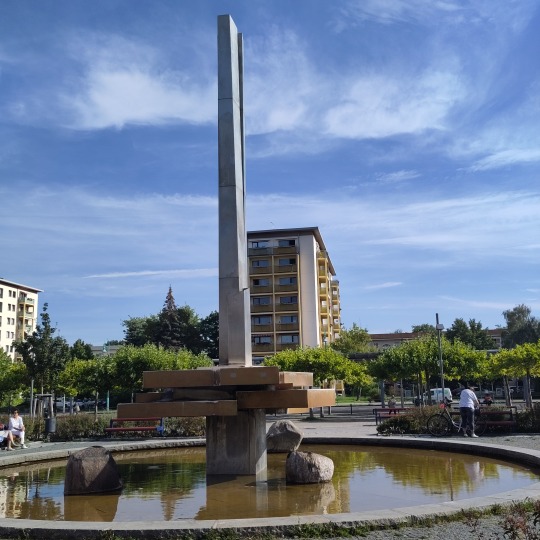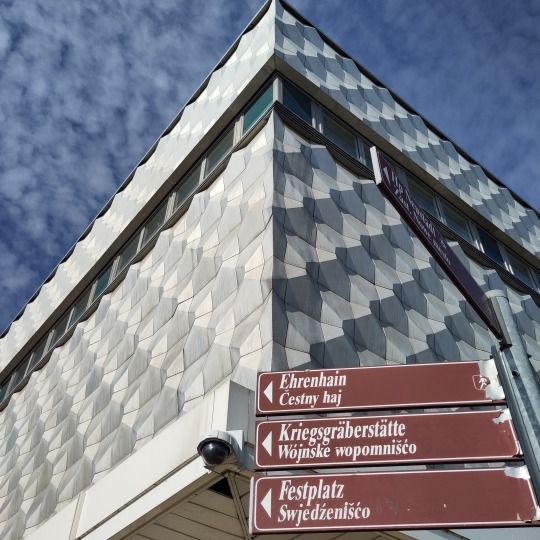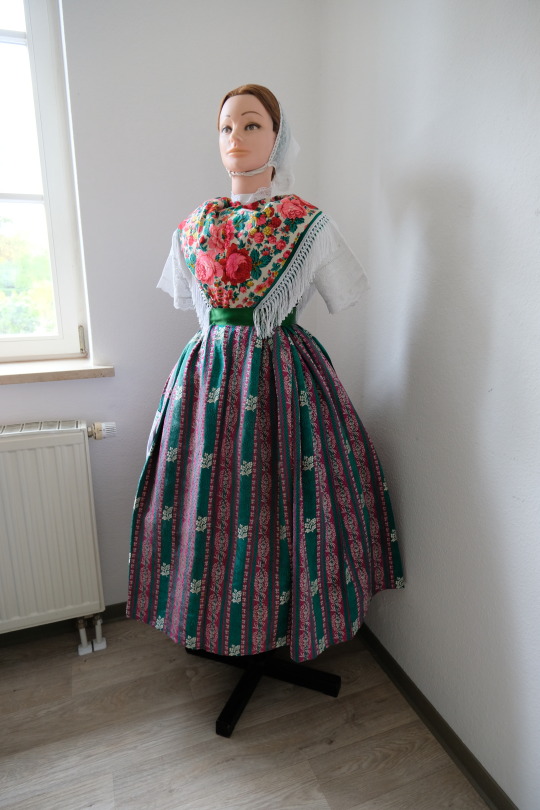#DOMOWINA
Explore tagged Tumblr posts
Text
L'oppression des Sorabes à l'époque nazie : une destruction systématique de l'identité culturelle
Par Riley Lewis À l’époque du national-socialisme, les Sorabes, une minorité slave occidentale de Lusace, ont été systématiquement privés de leurs droits, opprimés et privés de leur identité culturelle. Bautzen, un centre culturel des Sorabes, a été particulièrement touché, perdant presque toute forme d’autodétermination sorabe sous l’emprise répressive du régime nazi. Mais la persécution…
#ASSIMILATION CULTURELLE#BAUTZEN#CAMP DE CONCENTRATION#DESTRUCTION CULTURELLE#DOMOWINA#DROITS DES MINORITÉS#INTERDICTION DE LANGUE#MARGINALISATION ÉCONOMIQUE#MINORITÉ SLAVE OCCIDENTALE#NATIONAL-SOCIALISME#OPPRESSION CULTURELLE#PÈRE ALOIS ANDRITZKI#RÉPRESSION NAZIE#SORBES#TRAVAIL DE MÉMOIRE
0 notes
Text
Today in history: The 13th October 1912 - Domowina was founded for the first time.
»[…] Die fremdsprachigen Volksteile des Reiches dürfen durch die Gesetzgebung und Verwaltung nicht in ihrer freien volkstümlichen Entwicklung, Besonders nicht im Gebrauch ihrer Muttersprache beim Unterricht, sowie bei der inneren Verwaltung und der Rechtspflege beeinträchtigt werden.«
Was written in the Weimar Constitution. On english:
»[...] The foreign speaking ethnic groups of the Reich/ country should not be impaired by legislation and administration in their free development, especially not in the use of their mother tongue in teaching, as well as in internal administration and the administration of justice.«
"Does that mean the Sorbs were allowed to manage themselves with the allowance of using Sorbian, for example in official documents?", you may ask - technically! The Weimar Constitution used to be a progressive one for its time, but the people who made this possible were Domowina.
Domowina was founded on the 13th October 1912 in Hoyerswerda/ Wojerecy, by 60 representatives of 31 small sorbian organizations, to unite them and the sorbian people (divided by language, christian belief, and states) through one umbrella organisation. It was re-established after the first world war, and re-established a second time on the 10th may 1945, and fought for sorbian rights and the promotion of sorbian projects.
0 notes
Text
Tag 2. Hoyerswerda/Wojerecy
Getroffen mit Sonja Hrjehorjowa von dem sorbischen Landesverband Domowina (domowina.de). Getroffen mit Uwe Proksch von der Kulturfabrik Hoyerswerda (kufa-hoyerswerda.de). Einkaufen bei REWE und kurzer Schnack mit der Bäckereiverkäuferin aus NRW. Verabschiedung Steffi zurück nach Dresden. Selbstgekochtes Abendessen in einer kultischen Airbnb-wohnung. (sidefact: zwei airbnb-angebote in hoyerserda). Nächster Tag (07.09.2022) Einmal ins Lausitz-Center. Besondere Beobachtung: frische Blumensträuße sowohl auf der Damen- als auch Herrentoilette.
Intensive Themen: „Hoyerswerda 91“, Vertragsarbeiter:innen, sorbisches Leben
Zitat: „Ich konnte immer das machen, was ich wollte hier.“ (Uwe)
Visionäres Aushängeschild für Hoyerswerda: Stadt der zweisprachigen Selbstverständlichkeit







0 notes
Photo

Vergangenheit & Gegenwart: "Bereits 1946 kritisch zu den undemokratischen Strukturen der Domowina geäußert hat"
0 notes
Photo


Sorben - Serby Srbi 1900.!
Domowina Sorben ! https://www.domowina.de/start/
0 notes
Photo

Wojciech Kóčka ( Wójćech Kóčka ) - polski antropolog i archeolog, polski i serbołużycki działacz społeczny, sekretarz budziszyńskiego Komitetu Słowiańskiego, delegat Serbo-Łużyckiej Rady Narodowej, członek Komitetu Słowiańskiego w Polsce. Urodził się we wsi Wownjow (niem. Oehna) na Górnych Łużycach, leżącej obecnie w granicach miasta Budziszyna. W 1931 r. ukończył gimnazjum humanistyczne w Budziszynie i przez kilka miesięcy studiował na wydziale pedagogicznym politechniki w Dreźnie. Od 1932 r. przebywał w Polsce; po kursie na Uniwersytecie Ludowym w Dalkach koło Gniezna (gdzie co roku kształciło się po czterech Serbołużyczan) jeszcze w tym samym roku rozpoczął studia na Uniwersytecie Poznańskim w zakresie antropologii - u doc. Karola Stojanowskiego, prehistorii - u prof. Józefa Kostrzewskiego oraz etnografii i etnologii - u prof. dr Eugeniusza Frankowskiego. W 1936 r. uzyskał tytuł magistra filozofii z zakresu wymienionych dyscyplin na podstawie pracy Sunow, Konjecy, Ralbicy, Dobrosicy, Wownjow i Chrościcy pod względem antropologicznym. W czasie studiów brał udział w badaniach archeologicznych na terenie Wielkopolski, m.in. w latach 1934–1938 w Biskupinie i 1937–1938 w Gnieźnie oraz w inwentaryzacji grodzisk wczesnośredniowiecznych. Wyspecjalizował się w wykonywaniu dokumentacji fotograficznej wykopalisk, był głównym fotografem ekspedycji biskupińskiej. Wraz ze Zdzisławem Rajewskim zaprojektował balon na uwięzi do wykonywania zdjęć terenu wykopalisk z lotu ptaka, stając się w ten sposób jednym z pionierów archeologii lotniczej w Polsce. W 1937 r. za położone tam zasługi Kóčka został odznaczony Złotym Krzyżem Zasługi. W 1939 r. otrzymał obywatelstwo polskie i zawarł związek małżeński. Córką Wojciecha Kóčki jest Hanna Kóčka-Krenz - archeolog, profesor i dziekan Wydziału Historycznego Uniwersytetu im. Adama Mickiewicza w Poznaniu. W 1939 miał objąć stanowisko kierownika Muzeum w Grudziądzu, ale uniemożliwił to wybuch wojny. W lutym 1947 r. powrócił z Budziszyna do Polski i został adiunktem w Zakładzie Antropologii Uniwersytetu Wrocławskiego, brał udział w badaniach archeologicznych w Opolu na Ostrówku, a następnie we Wrocławiu. W 1948 r. otrzymał we Wrocławiu stopień doktora nauk przyrodniczych na podstawie pracy Wczesnodziejowa antropologia Słowian. Od 1949 r. aż do śmierci kierował wykopaliskami na Ostrowie Tumskim we Wrocławiu z ramienia Kierownictwa Badań nad Początkami Państwa Polskiego. W 1954 r. został docentem Uniwersytetu Wrocławskiego i kierownikiem Stacji Archeologicznej Instytutu Historii Kultury Materialnej PAN. W 1955 r. objął stanowisko docenta przy Katedrze Archeologii Polski IHKM w Poznaniu, później przekształconej w Zakład Archeologii Wielkopolski i Pomorza. W 1959 r. mianowano go profesorem nadzwyczajnym Uniwersytetu Adama Mickiewicza, w 1960 r. kierownikiem Katedry Archeologii Polski i Powszechnej UAM. Zmarł niespodziewanie po operacji w szpitalu. Jego zainteresowania naukowe wiązały się z problemami etnogenezy ludów europejskich, zwłaszcza Słowian, które starał się rozpatrywać metodami antropologii fizycznej, archeologii i językoznawstwa. Z kilkudziesięciu wydanych przez niego prac naukowych największe znaczenie, poza sprawozdaniami terenowymi z wykopalisk archeologicznych, ma jego rozprawa habilitacyjna, opublikowana w formie książkowej pt. Zagadnienia etnogenezy ludów Europy (Wrocław 1959). W okresie okupacji ukrywał się przed nazistami w Starym Mieście pod Leżajskiem, skąd pochodziła jego żona, a następnie w Mogielnicy w powiecie grójeckim. Pomimo iż był poszukiwany przez Gestapo, był zaangażowany w działalność podziemną, ucząc na tajnych kompletach. Wkrótce po zakończeniu wojny udał się na Łużyce, gdzie piastował stanowisko sekretarza związku Serbów łużyckich „Domowina” z siedzibą w Budziszynie. Istniał wówczas projekt proklamowania niezależnego państwa Serbołużyczan, a Wojciech Kóčka był kandydatem na premiera tego państwa. Gdy zdał sobie sprawę z nierealności (głównie na skutek braku zgody Sowietów) tych zamierzeń, próbował wraz z rodziną wrócić do Polski, ale został aresztowany na granicy i odesłany do Budziszyna. Następnie przedostał się nielegalnie do Czechosłowacji, gdzie ukrywał się niemal przez rok. Jeszcze w tym okresie pełnił rolę emisariusza Domowiny w różnych negocjacjach z rządem polskim, m.in. z ówczesnym wicepremierem i ministrem Ziem Odzyskanych Władysławem Gomułką. Był sekretarzem budziszyńskiego Komitetu Słowiańskiego a następnie członkiem Komitetu Słowiańskiego w Polsce. Uczestnik plenum Komitetu Wszechsłowiańskiego w Warszawie w roku 1947.
0 notes
Photo

Coat Of Arms Of The Serbs (Sorbs)
Sorabi, any member of the Slavic minority in Eastern Germany. Sorabi are concentrated in the Valley of the river Spree, in the area of the Bautzen (Budyšin) and Cottbus. This area was part of the traditional region of Lusatia (q.v.), whose history is closely linked with Sorabi. Sorabi are descendants of two small Slavic tribes, the Lužiči and the Milčani, who were gathered the main tribe known as the Sorbs. The latter were one of a number of Slavic tribes collectively known as the Wends, who lived in the area between the river Elbe and Oder for centuries until they were subdued and assimilated by the Germans in the late Middle Ages. Although surrounded by Germans for centuries, today's Sorbs were able to preserve their ethnic identity, language, literature, and traditions. Sorabi are mostly Roman Catholics and use the alphabet of Latin origin.
youtube
Bautzen, city, Saxony Land (state), eastern Germany. It lies in the Oberlausitz (Upper Lusatia) region, on a granite elevation above the Spree River. Bautzen was originally the Slavic settlement of Budissin (Budyšin), and the Peace of Bautzen was concluded there in 1018 between the German king Henry II and the Polish king Bolesław I. The city became German in 1033, passing to Bohemia in 1319 and to Saxony in 1635. The capital of the Federation of Lusatian cities in 1346, it was and is an important political and cultural centre of the Lusatian Sorbs, a West Slavic people also called the Wends, or Domowina. Sorb traditions and customs are kept alive by the Institute of Sorbian Studies, located in Bautzen. Bautzen gives its name to the hard-fought battle of May 20–21, 1813, in which French troops under Napoleon I defeated a Russo-Prussian army. The city is a railway junction, and its economy is broadly based, including a thriving service sector and a variety of manufacturing activities. Notable buildings include the Ortenburg Castle (1483–86) and St. Peter’s Church (1220–1497), which has been shared since 1523 by Roman Catholics and Protestants and has, since 1921, served as the Roman Catholic cathedral and seat of the bishop of Meissen.
0 notes
Link
0 notes
Quote
* * * (Czemu mnie z trumny...) Czemu mnie z trumny wyciągasz czemu szepczesz kochany...kochany... Trumna z kołysek najpewniejsza. Po co mnie ciągnąć po światłach, po ludziach, po czasach? Mnie tylko trumna potrzebna, dom mój, domowina. Ja już i krzyża nie chcę, nie chcę już krzyża na trumnie. Dawnoż to było, gdy stałem pomiędzy nicością a krzyżem, dzisiaj spod krzyża i z krzyża wołam już tylko nicości!
Aleksander Wat
1 note
·
View note
Text
Útlak Lužických Srbů v době nacismu: systematické ničení kulturní identity
Napsal(a) Riley Lewis Během nacionálního socialismu byli Lužičtí Srbové, západoslovanská menšina v Lužici, systematicky zbavováni volebního práva, utlačováni a okrádáni o svou kulturní identitu. Budyšín, kulturní centrum Lužických Srbů, byl zasažen obzvláště těžce, protože pod represivním sevřením nacistického režimu ztratil téměř všechny formy lužickosrbského sebeurčení. Pronásledování však…
#BUDYŠÍN#DOMOWINA#EKONOMICKÁ MARGINALIZACE#JAZYK BAN#KONCENTRAČNÍ TÁBOR#KULTURNÍ ASIMILACE#KULTURNÍ ÚTLAK#KULTURNÍ NIČENÍ#LUŽIČTÍ SRBOVÉ#Nacistické represe#OTEC ALOIS ANDRITZKI#PRÁVA MENŠIN#VZPOMÍNKOVÉ DÍLO#ZÁPADOSLOVANSKÁ MENŠINA
0 notes
Text
Europeada 2024 - "between the seas"

Europeada 2022 in Kärnten/Koroška, Austria.
In the beginning of this March, the sorbian woman's football Team met for the first training in Ralbitz/Ralbicy: The Sorbs & Domowina planned to organize a woman's team next to the already existing men's team for the next great international tournament, the Europeada 2024.
The Europeada is a football League existing since 2008 for European minorities, and is going to take place next to Flensburg next year, from the 28th June to 7th july. Hosts are the Danes of Germany, Germans of Denmark, Rroma/Sinti, and the Frisians.
The Sorbs had already been hosts of the Europeada in 2012 in Bautzen/Budyšin.
#german football#football#european football#European minorities#Europeada#Europeada 2024#Europe#minority#minority languages#file: unspecified
1 note
·
View note
Text
CDU sucht einen nichtdeutschen Kanzler!
Die CDU sucht einen nichtdeutschen Kanzler als Kanzler für Deutschland. Ich melde mich freiwillig als nichtdeutscher Kanzler!
Denn wie bekannt, wurde ich nur versehentlich in Deutschland wiedergeboren – und das auch noch OHNE die mir zustehenden Mandel- bzw. Mondsichelaugen! Mit wendischem Großvater wäre ich ein halber (oder bloß Viertel? Ich kenne mich in der korrekten Nazi-Prozentrechnung nicht…
View On WordPress
#AXA#Brandanschlag#CDU#Chdorkowski#Domowina#Genscher#Hab und Gut#nichtdeutscher Kanzler#Serbja#Sorben#Unhab und Ungut#Wenden
0 notes
Text
L'oppressione dei sorbi durante l'era nazista: una distruzione sistematica dell'identità culturale
Di Riley Lewis Durante l’era nazionalsocialista, i Sorbi, una minoranza slava occidentale in Lusazia, furono sistematicamente privati dei loro diritti, oppressi e derubati della loro identità culturale. Bautzen, centro culturale dei Sorbi, fu particolarmente colpita, perdendo quasi ogni forma di autodeterminazione soraba sotto la morsa repressiva del regime nazista. Ma la persecuzione si estese…
#ASSIMILAZIONE CULTURALE#BAUTZEN#CAMPO DI CONCENTRAMENTO#DIRITTI DELLE MINORANZE#DISTRUZIONE CULTURALE#DIVIETO DI LINGUA#DOMOWINA#MARGINALIZZAZIONE ECONOMICA#MINORANZA SLAVA OCCIDENTALE#NAZIONALSOCIALISMO#OPERA DELLA MEMORIA#OPPRESSIONE CULTURALE#PADRE ALOIS ANDRITZKI#REPRESSIONE NAZISTI#SORBI
0 notes
Text
De onderdrukking van de Sorben tijdens het nazi-tijdperk: een systematische vernietiging van de culturele identiteit
Door Riley Lewis Tijdens het nationaalsocialistische tijdperk werden de Sorben, een West-Slavische minderheid in Lausitz, systematisch rechteloos gemaakt, onderdrukt en beroofd van hun culturele identiteit. Vooral Bautzen, een cultureel centrum van de Sorben, werd zwaar getroffen en verloor bijna elke vorm van Sorbische zelfbeschikking onder de repressieve greep van het naziregime. Maar de…
#BAUTZEN#CONCENTRATIEKAMP#CULTURELE ASSIMILATIE#CULTURELE DESTRUCTIE#CULTURELE ONDERDRUKKING#DOMOWINA#ECONOMISCHE MARGINALISERING#HERDENKING WERK#NATIONAALSOCIALISME#RECHTEN VAN MINDERHEDEN#REPRESSIE VAN DE NAZI&039;S#SORBS#TAAL BAN#VADER ALOIS ANDRITZKI#WEST-SLAVISCHE MINDERHEID
0 notes
Text
Förtrycket av sorberna under nazitiden: En systematisk förstörelse av den kulturella identiteten
Av Riley Lewis Under den nationalsocialistiska eran blev sorberna, en västslavisk minoritet i Lusatien, systematiskt berövade sina rättigheter, förtryckta och berövade sin kulturella identitet. Bautzen, ett kulturellt centrum för sorberna, drabbades särskilt hårt och förlorade nästan alla former av sorbiskt självbestämmande under nazistregimens repressiva grepp. Men förföljelsen sträckte sig…
#BAUTZEN#DOMOWINA#EKONOMISK MARGINALISERING#FADER ALOIS ANDRITZKI#KONCENTRATIONSLÄGER#KULTURELL ASSIMILERING#KULTURELL FÖRSTÖRELSE#KULTURELLT FÖRTRYCK#MINNESARBETE#MINORITETERS RÄTTIGHETER#NATIONALSOCIALISM#Nazisternas förtryck#SPRÅK BANAN#SVAVEL#VÄSTSLAVISKA MINORITETEN
0 notes
Text
A szorbok elnyomása a náci korszakban: a kulturális identitás szisztematikus megsemmisítése
Írta: Riley Lewis A nemzetiszocialista korszakban a szorbokat, a lusatiai nyugatszláv kisebbséget szisztematikusan megfosztották joguktól, elnyomták és megfosztották kulturális identitásuktól. Bautzent, a szorbok kulturális központját különösen súlyosan érintette, mivel a náci rezsim elnyomó szorításában elvesztette a szorb önrendelkezés szinte minden formáját. Az üldözés azonban messze…
#ALOIS ANDRITZKI ATYA#BAUTZEN#DOMOWINA#EMLÉKEZETMŰ#KISEBBSÉGI JOGOK#KONCENTRÁCIÓS TÁBOR#KULTURÁLIS ASSZIMILÁCIÓ#KULTURÁLIS ELNYOMÁS#KULTURÁLIS PUSZTÍTÁS#Náci elnyomás#NEMZETISZOCIALIZMUS#NYELVI TILTÁS#NYUGATSZLÁV KISEBBSÉG#SZORBOK
0 notes